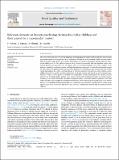Por favor, use este identificador para citar o enlazar a este item:
http://hdl.handle.net/10261/257728COMPARTIR / EXPORTAR:
 SHARE SHARE
 CORE
BASE CORE
BASE
|
|
| Visualizar otros formatos: MARC | Dublin Core | RDF | ORE | MODS | METS | DIDL | DATACITE | |

| Título: | Relevant elements on biscuits purchasing decision for coeliac children and their parents in a supermarket context |
Autor: | Puerta, Patricia CSIC ORCID; Laguna Cruañes, Laura CSIC ORCID; Tárrega, Amparo CSIC ORCID; Carrillo, Elizabeth CSIC ORCID | Palabras clave: | Coeliac children Eye-tracking Eye-tracking Gluten-free Laddering Purchasing decision Simulated context |
Fecha de publicación: | 1-jun-2022 | Editor: | Elsevier | Citación: | Food Quality and Preference 98: 104496 (2022) | Resumen: | The aim of this work was to study the behaviour and motivations of coeliac children and their parents when purchasing biscuits. Four groups (n = 30) of participants differing in coeliac condition (coeliac and non-coeliac) and age (children and parents) were studied. Participants were asked to “purchase” biscuits, either for themselves (children) or for their children (parents), in a simulated supermarket aisle that included twelve commercial biscuits (six gluten-free and six regular ones). Eye-tracking technique was used to register visual attention during the purchasing exercise and laddering interviews were used to obtain the self-reported reasons for their choice. The number of fixations received by biscuits and label elements were analysed and most of them varied depending on the coeliac condition, the age or both. In comparison with the non-coeliac children, coeliac children fixated more on the ingredients, gluten-free words and symbols, and fixated less on the biscuit image. Parents of coeliac children put more attention on the ingredients and the certified gluten-free symbol, and less attention on the biscuit image, product name, cartoon, and nutritional information than non-coeliac parents. According to the chains of reasons (attribute-consequence-value), all children looked for pleasure as the final value, but only coeliac children showed interest in the brand and in unknown products they want to try. Parents differed on the attributes linked to health that were certification logo and a short ingredient list for coeliac group, and low sugar or fat contents for non-coeliac one. Trust and economy were relevant only for parents of coeliac children. | URI: | http://hdl.handle.net/10261/257728 | DOI: | 10.1016/j.foodqual.2021.104496 | ISSN: | 0950-3293 |
| Aparece en las colecciones: | (IATA) Artículos |
Ficheros en este ítem:
| Fichero | Descripción | Tamaño | Formato | |
|---|---|---|---|---|
| FQP2022-Puerta.pdf | Artículo principal | 3,87 MB | Adobe PDF |  Visualizar/Abrir |
CORE Recommender
SCOPUSTM
Citations
6
checked on 01-may-2024
WEB OF SCIENCETM
Citations
4
checked on 27-feb-2024
Page view(s)
66
checked on 04-may-2024
Download(s)
128
checked on 04-may-2024
Google ScholarTM
Check
Altmetric
Altmetric
Este item está licenciado bajo una Licencia Creative Commons

